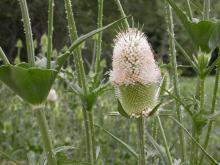Wildflowers, Grasses and Other Nonwoody Plants
Media

Species Types
Scientific Name
Geranium maculatum
Description
Called “crane’s bill” for its sharply pointed seed capsules, wild geranium is a gardening favorite, and there are cultivated varieties of this woodland wildflower bred for unique petal and leaf colors.
Media

Species Types
Scientific Name
Dipsacus fullonum and D. laciniatus
Description
“Infestation” is the term for what teasels are doing in Missouri. Learn to identify these thistlelike plants, and help to control the weedy spread of these tough, prickly invaders.
Media

Species Types
Scientific Name
Asclepias hirtella
Description
Prairie milkweed’s full, rounded clusters of small, delicately purple-tinged flowers set it apart from other prairie milkweeds.
Media

Species Types
Scientific Name
Penstemon cobaea
Description
Cobaea beardtongue, or purple beardtongue, is probably Missouri’s showiest species of penstemon. Native to Missouri's southern Ozarks, it is grown statewide for its beauty, and because pollinators like it. It may be purple or white.
Media

Species Types
Scientific Name
Subfamily Asclepiadoideae
Description
Milkweeds are a group of plants that used to have their very own family. Now part of the dogbane family, they’re still a pretty distinctive group.
See Also
About Wildflowers, Grasses and Other Nonwoody Plants in Missouri
A very simple way of thinking about the green world is to divide the vascular plants into two groups: woody and nonwoody (or herbaceous). But this is an artificial division; many plant families include some species that are woody and some that are not. The diversity of nonwoody vascular plants is staggering! Think of all the ferns, grasses, sedges, lilies, peas, sunflowers, nightshades, milkweeds, mustards, mints, and mallows — weeds and wildflowers — and many more!





















